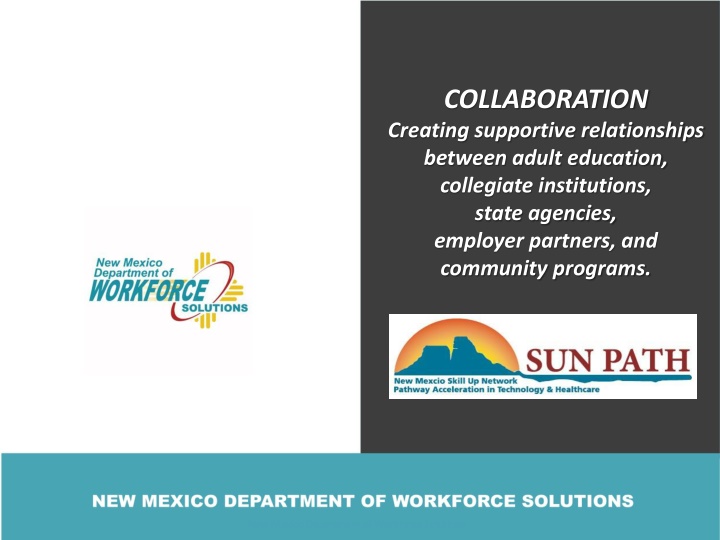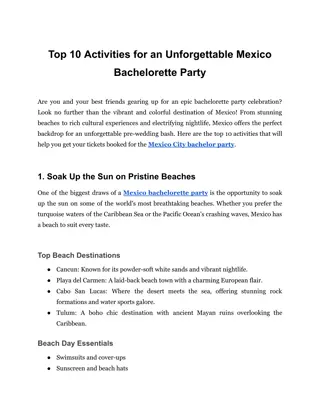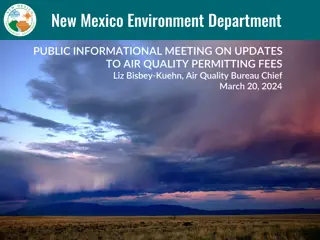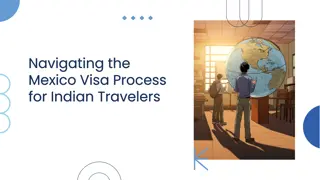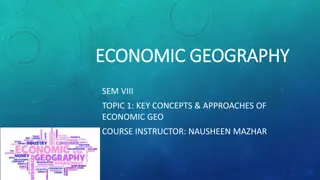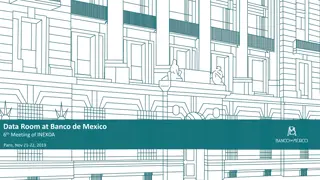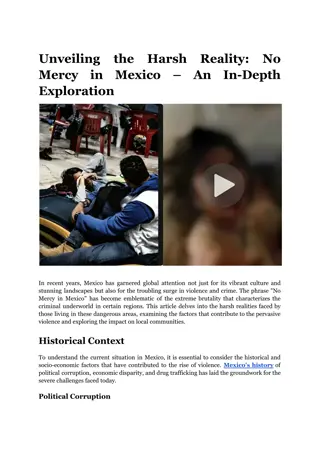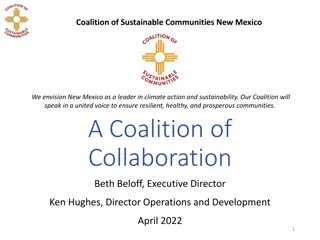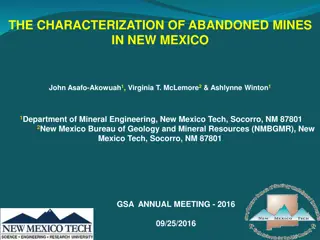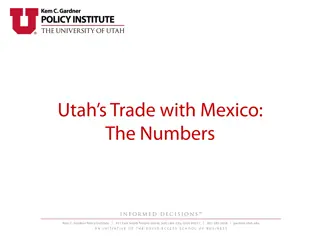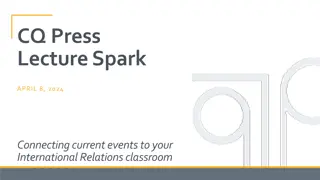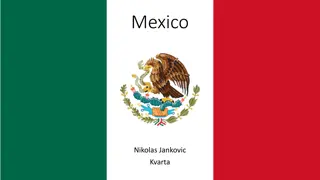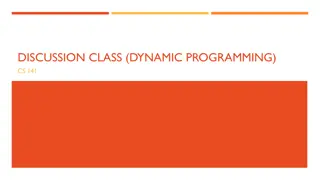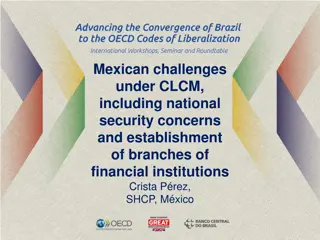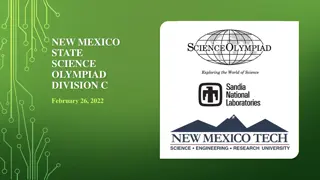Maximizing Collaboration for Educational and Economic Success in New Mexico
This presentation focuses on fostering supportive relationships between adult education, collegiate institutions, state agencies, employer partners, and community programs in New Mexico to enhance workforce solutions. It emphasizes the importance of effective partnerships, outlining key strategies and outcomes needed for successful collaboration. Through a win-win approach and clear goal setting, the aim is to serve students and the community by achieving academic, professional, and economic milestones. The session also delves into the significance of defining outcomes upfront and engaging relevant stakeholders to ensure a sustainable and impactful collaborative effort.
Download Presentation

Please find below an Image/Link to download the presentation.
The content on the website is provided AS IS for your information and personal use only. It may not be sold, licensed, or shared on other websites without obtaining consent from the author.If you encounter any issues during the download, it is possible that the publisher has removed the file from their server.
You are allowed to download the files provided on this website for personal or commercial use, subject to the condition that they are used lawfully. All files are the property of their respective owners.
The content on the website is provided AS IS for your information and personal use only. It may not be sold, licensed, or shared on other websites without obtaining consent from the author.
E N D
Presentation Transcript
COLLABORATION Creating supportive relationships between adult education, collegiate institutions, state agencies, employer partners, and community programs. New Mexico Department of Workforce Solutions
AGENDA WHY? Starting with the outcomes and working backwards. WHO? WIOA Partners, Colleges, Employer Partners, Community Organizations. HOW? What makes for an effective partnership?
COLLABORATION Collaboration is not a nice to have organizational philosophy. It is an essential ingredient for organizational survival and success. Forbes Magazine. February 13, 2014. LINK: The Twelve Principles of Collaboration Activity 1: Three Skills Needed for Professional Collaboration.
The WHY? WIN / WIN Just like building relationships with students lays the groundwork for academic success, building relationships with colleagues lays the groundwork for effective collaboration. Pooling our knowledge and resources to achieve our benchmark requirements for funding. Modeling effective collaboration for our students!
DEFINE YOUR OUTCOMES FIRST TYPE? FOR WHOM? Students DWS Adult Education TANF CYFD DVR Community Agencies/ Non-Profits Post-Secondary Business Community ETC. Academic Professional Technical Life Skills Activity 2: What Outcomes Are You Seeking?
WHAT IS THE END RESULT? Serving the Students and Community! GOALS BENCHMARKING Simultaneously obtain HSE and place into credit-bearing college courses Enrollment, retention, and completion within degree programs Industry credentials received Successful job attainment Wage increases over a 1 to 5 year follow up Cultivate exemplary professionalism and life skills Contribute to economic development via IET tracks Student Retention Successful Completion Graduation Employment Fiscally Sustainable Increased Quality of Life
The WHO? Who should participate, who has a vested interest, who will be engaged? Who will act? If the right providers are not present with a common goal and buy-in, it is likely the collaboration will not succeed. So who do you choose to share your information with? Our agencies, schools, programs, and students do not exist in isolation and cannot go it alone. Activity 3: What Do You Know About WIOA?
WORKFORCE INNOVATION OPPORTUNITY ACT (WIOA 2017) Collaboration Between Title Grants 1 to 4: Four Workforce Development Boards oversee funds allocated for the State of NM from the Governor. Northern Board Counties: (Cibola, Colfax, Los Alamos, McKinley, Mora, Rio Arriba, San Juan, Santa Fe, San Miguel and Taos). New Mexico Department of Workforce Solutions (DWS), SER Jobs for Progress Wagner-Peyser: Adult/Youth (Titles 1, 3) Central Board Counties: (Sandoval, Bernalillo, Valencia, and Torrance). Adult Education (AE-Title 2) Southwestern Board Counties: (Catron, Socorro, Sierra, Grant, Hidalgo, Luna and Dona Ana). Department of Vocational Rehab (DVR-Title 4) Affiliate Partners: Temporary Assistance for Needy Families (TANF- Title 1) CYFD (Title 1 for Childcare Stipends) and The Community Colleges! Eastern Board Counties: (Chaves, Curry, De Baca, Eddy, Guadalupe, Harding, Lea, Lincoln, Otero, Quay, Roosevelt, and Union).
DEPARTMENT OF WORKFORCE SOLUTIONS The New Mexico Department of Workforce Solutions' Workforce Connection brings together workforce development services such as employment, training, education, and more, in a customer-friendly central location where businesses, job seekers, workers, and employers can find answers to their workforce questions. This is referred to as a One-Stop Center. LINK: New Mexico Workforce Connection Tell Us What You Know
ADULT EDUCATION Nationally, the field of Adult Education teachers are experts in research- based best practices for working with unprepared learners. Students learn how to learn, gain rigorous academic ability, and foster strong life and professionalism skills. Tell Us What You Know AE is taking the lead in IET development for across the state allows adult education students to concurrently enroll in IETs, with objective of bypassing developmental education and/or obtain an HSE upon completion. AE supports development of professionalism and life skills with intensive coaching and advising, and workshops. AE curriculum can be career integrated, allowing for students to gain basic reading, writing, and math skills while learning a technical trade. Continued collaboration and reduction in the duplication of services between adult education and development/remedial education.
TANFCash Allowance The New Mexico Temporary Assistance for Needy Families (TANF) program, known as NMWorks, is designed to help needy families achieve self- sufficiency. Tell Us What You Know States receive grants to design and operate programs that accomplish one of the purposes of the TANF program. New Mexico has received a $1 million grant to assist TANF recipients, in a referral process with SUN PATH. Tuition Books Fees Supplies: Backpacks, notebooks, pens, etc. Required Program Materials: Scrubs, Stethoscope, BP Cuff, etc. UNM-Valencia leads the ACCE program in collaboration with TANF and other Adult Education programs to support clients in obtaining in their High School Equivalency.
DEPARTMENT OF VOCATIONAL REHAB DVR The mission of the New Mexico Division of Vocational Rehabilitation (NMDVR) is to encourage and assist the efforts of New Mexicans with disabilities to reach their goals for working and living in their communities. Tell Us What You Know DVR assists with tuition, books, fees, and further financial assistance. DVR will provide the following: Vocational Counseling and Guidance Job Search Assistance / Development / and Placement Pre-Employment Transition Vocational Rehabilitation Technology Training Post-Employment Services
INTEGRATED EDUCATION AND TRAINING Chart: How Career Technical Training, Academic Rigor, and Explicit Professionalism Skills Training Work Together.
WHAT STATE AND FEDERAL FUNDING STREAMS ARE AVAILABLE? How to connect and align students with the funding necessary to retain and sustain them? HELP NM (SER) Paid Internships Ability to Benefit (ATB) In-demand industry Perkins tuition dollars for those without an HSE Veteran Programs Community Foundations Business Sponsorship Ex: Chevron Mining is funding Taos Adult Education program, TECC, to launch a Solar Technician IET to launch this fall. TANF SUN PATH funding ACCE Program for obtaining an HSE Employer Ex: Many health care providers will cover cost for credentialing. WIOA Training Dollars In-demand industry Other barriers to qualify Rotary Club Scholarships for technical trades. CYFD Child-care stipends Get Creative! DVR Tuition/Living expenses
INTER-COLLEGIATE COLLABORATION How to find out ALL the resources available in your surroundings.
RESOURCES AVAILABLE WITHIN THE COLLEGE AND WITHIN ADULT EDUCATION Learn what resources are available within your facility: Academic Support Tutoring, Veterans, Native American, Hispanic, 1stGeneration College Students Financial Support Financial Aid, Edge Program, Enlace, Kellogg Grant any additional grants Career Counseling Emotional / Mental Support Advising and Counseling, Achievement Center (Student Services) Disability Services English as a Second Language and Citizenship Classes
INCLUDING EMPLOYER PARTNERS Begin the process of integrating employers into the education process.
EMPLOYER PANELS Provide descriptive overview and research behind IET model, i.e. the three circles, IBEST, etc. Introduce employers to instructors and staff allow time to showcase curricula. Students gain leadership and professionalism skills as they interview the employers. Excellent training for being an interviewee = practice being the interviewer. Allow time for employers to ask questions of students, staff, and faculty.
IET AND EMPLOYER PANELS IMAGES. LEFT: Three Circles Integrated Education and Training (IET) Graphic to Share with Employers. RIGHT: Employer Panel Flyer.
JOB ORDERS, JOB OPENINGS AND JOB PLACEMENT THROUGH EMPLOYER PARTNERS Collaboration with employers = long-term success! Allows for notification of openings for a specific employer or within a career pathway. Word of mouth: Our college produces great workers! Reciprocal: Include them in mock interviews. Invite them to speak within the classrooms about Career Pathways and Jobs. Provide them potential applicants for employment. Job Shadowing.
HOW? How do you take the steps to make it effective and efficient? Host Regular, Intentional Meetings
A FEW ELEMENTS OF EFFECTIVE PARTNERSHIP (Information Source: Pulled from Adult Education Consultant Jeff Fontaine s work and other leaders in the field) 1. Mutual Respect for Knowledge and Skills. 2. Explicitly Stated, Common Understanding of Values and Goals. 3. Co-Accountability, Co-Planning, Co-Evaluation. 4. Reflective Practice = plan, act, reflect, adjust! Ongoing, consistent, and collaborative feedback. 5. Established Agreements (MOU). Activity 4: Teamwork, conflict resolution, professionalism = we are models for our students. How do we actually make this work? What are the barriers and how can you overcome them? Activity 5: What are your takeaways, how will you act on this?
CONCLUSION Jeanne Winchell DWS JDCC SJC Jeanne.Winchell@state.nm.us (505) 566-3861 Nina Gonzales Program Specialist / JDCC TECC@UNM-Taos ninafeliz@unm.edu (575) 737-3732
ACKNOWLEDGEMENTS This workforce product was funded by a grant awarded by the U.S. Department of Labor s Employment and Training Administration. The product was created by the grantee and does not necessarily reflect the official position of the U.S. Department of Labor. The U.S. Department of Labor makes no guarantees, warranties, or assurances of any kind, express or implied, with respect to such information, including any information on linked sites and including, but not limited to, accuracy of the information or its completeness, timeliness, usefulness, adequacy, continued availability, or ownership. Although the authoring institution of this educational resource has made every effort to ensure that the information presented is correct, the institution assumes no liability to any party for any loss, damage, or disruption caused by errors or omissions. Except where otherwise noted, this work by SUN PATH Consortium is licensed under the Creative Commons Attribution 4.0 International License. To view a copy of this license, click on the following link: Creative Commons License 4.0.
